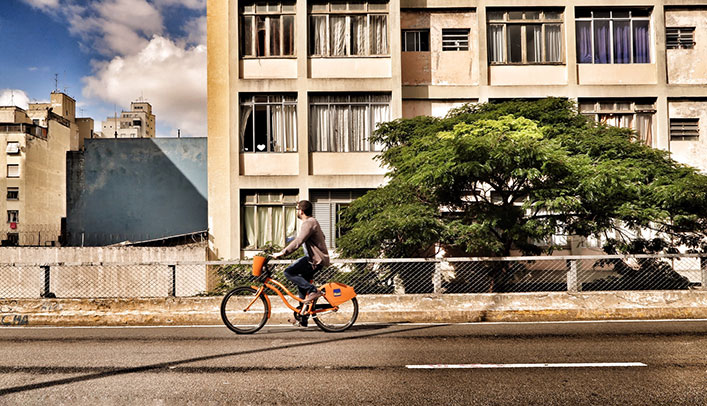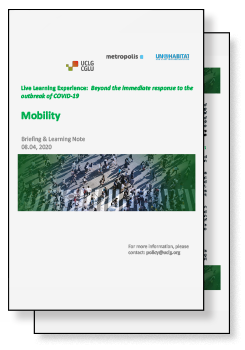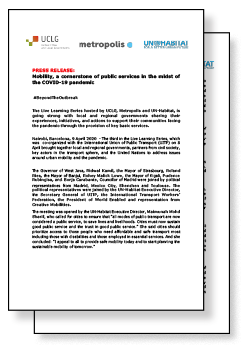Mobility
Under-Secretary-General of the United Nations and Executive Director of UN-Habitat
Secretary General of UITP
UCLG Secretary General

Re-live the Live Learning
Experience about Mobility

Context
Mobility is one of the basic functions that keep the urban system running. It is also likely to be one of the sectors that will change most in the future as a result of technological innovation and behavior change. Positive changes in urban mobility could improve cities’ health, land use, energy efficiency and use of renewables as well as improve access to socio-economic opportunities; a transition to a more inclusive and sustainable urban mobility model could and should be accelerated as a result of COVID-19. Since the outbreak, cities are facing the challenge of providing safe, reliable public transport while ensuring the health of public service providers and users. In parallel, alternative transport methods – such as bicycles or e-scooters – have gained prominence in the public debate, as they are now not only environmentally friendly, but also as a safe way to move around the city.
8%
Bicycles account for about 8% of urban transport modes
52%
while cars account for about 52%
Challenges
When developing sustainable transport solutions, cities face the challenge of finding ways to improve urban mobility while reducing congestion, accidents and pollution. Ensuring usability and continuity of services is key for citizens who have limited mobility options and those in “transport poverty”, particularly in times of emergencies such as the COVID-19. During the outbreak, fear of exposure to the virus might decrease residents’ reliance on public transport. As a response, local authorities should explain the measures being taken to protect workers and users as well as inform of recommended behavior at the individual level when using these services.
Needs
Cities must see urban transport as a democratizing tool to achieve the right to the city. The current pandemic is an opportunity to rethink urban transport models and move towards inclusive, affordable, accessible, integrated and sustainable transport systems while unleashing the potential of emerging technologies to bring down congestion, air pollution and the incidence of road traffic accidents. These systems should support the redistribution of opportunities among inhabitants, with particular attention to vulnerable groups such as women, children, persons with disabilities and migrants, especially during the COVID-19 outbreak. Local governments should also consider the needs of those working in the informal sector, who will be highly impacted by the crisis and whose economic opportunities largely depend on public transport.
Responses
Strasbourg has adapted its public transport offer to match health sector’s needs
Banjul is making an effort to provide clear information for workers and users who need to take public transport during the pandemic
Mexico City is ensuring a high frequency of public transport service to address the need of social distancing
Responses
Key Takeaways
- The maintenance of proper public transportation services is absolutely key for a safe and efficient urban management during emergencies as well as for access to opportunities.
- The current emergency can be seen as an opportunity to accelerate the transition towards more sustainable urban mobility options.
- Public-private partnerships are a good strategy to provide urban mobility alternatives during the pandemic.
- Strict measures should be put in place at the local level to guarantee the safety of both workers and passengers in public transport. Only then will it be a reliable mean of transportation during and after the crisis.
- Specific measures should be taken aimed at guaranteeing safe, reliable urban transport access to vulnerable communities, including those working in the informal sector, women and people with disabilities.
Beyond
The Outbreak
Victor Pineda, President of World Enabled, invites us to think about “who are our cities built for” and plan for emergency and recovery mobility policies accordingly. If we want to make urban transportation inclusive, we must create solutions that address people with disabilities – which make between 15% and 20% of urban citizens. In that sense, he highlighted that the current crisis provides an opportunity to build back more resilient and improved mobility systems by making public transport more inclusive and accessible for all.

Building
Back Better
The UCLG Decalogue

Resources

For further information on the topic of Mobility and its impact on cities and regions, please refer to the related resources included below.



